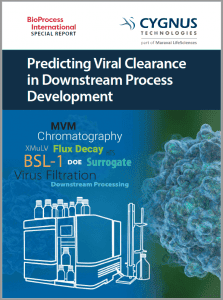- Sponsored Content
- Viral Clearance
Predicting Viral Clearance in Downstream Process DevelopmentPredicting Viral Clearance in Downstream Process Development
May 27, 2021
Sponsored by Cygnus Technologies
 As viruses can arise during the manufacture of biopharmaceuticals, regulatory agencies require viral clearance validation studies for each biopharmaceutical prior to approval. These studies are typically conducted in biosafety level (BSL)-2 facilities and require large capital and human resources. The use of an accurate, economical, and quantifiable noninfectious viral surrogate would enable downstream purification scientists to study viral clearance throughout process development. This report explores the use of a BSL-1 compatible, noninfectious MVM particles to predict viral clearance results over a wide variety of process development applications such as anion-exchange chromatography (AEX) design of experiments (DOE) study, ion-exchange chromatography (IEX) high-throughput screening, and downstream purification of an adenoassociated virus (AAV)-based viral vector.
As viruses can arise during the manufacture of biopharmaceuticals, regulatory agencies require viral clearance validation studies for each biopharmaceutical prior to approval. These studies are typically conducted in biosafety level (BSL)-2 facilities and require large capital and human resources. The use of an accurate, economical, and quantifiable noninfectious viral surrogate would enable downstream purification scientists to study viral clearance throughout process development. This report explores the use of a BSL-1 compatible, noninfectious MVM particles to predict viral clearance results over a wide variety of process development applications such as anion-exchange chromatography (AEX) design of experiments (DOE) study, ion-exchange chromatography (IEX) high-throughput screening, and downstream purification of an adenoassociated virus (AAV)-based viral vector.
Fill out the form below to read the special report now and learn more about applying a noninfectious viral surrogate to help study viral clearance capability.
You May Also Like





